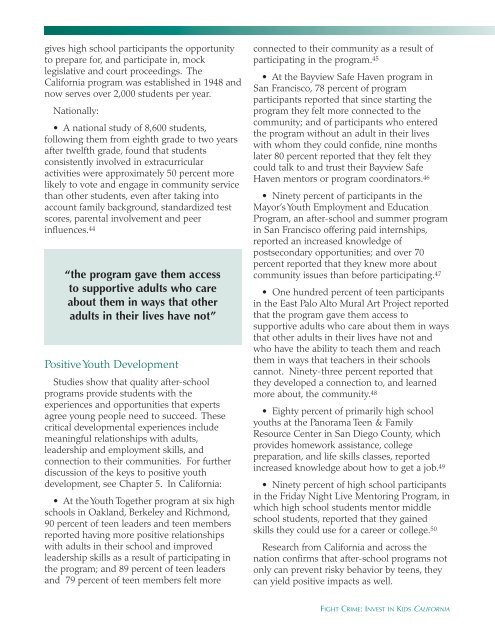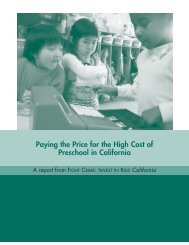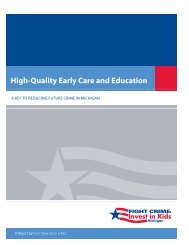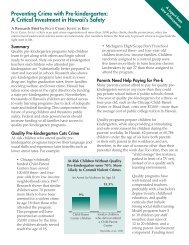California's Next After-School Challenge - Fight Crime: Invest in Kids
California's Next After-School Challenge - Fight Crime: Invest in Kids
California's Next After-School Challenge - Fight Crime: Invest in Kids
You also want an ePaper? Increase the reach of your titles
YUMPU automatically turns print PDFs into web optimized ePapers that Google loves.
gives high school participants the opportunity<br />
to prepare for, and participate <strong>in</strong>, mock<br />
legislative and court proceed<strong>in</strong>gs. The<br />
California program was established <strong>in</strong> 1948 and<br />
now serves over 2,000 students per year.<br />
Nationally:<br />
• A national study of 8,600 students,<br />
follow<strong>in</strong>g them from eighth grade to two years<br />
after twelfth grade, found that students<br />
consistently <strong>in</strong>volved <strong>in</strong> extracurricular<br />
activities were approximately 50 percent more<br />
likely to vote and engage <strong>in</strong> community service<br />
than other students, even after tak<strong>in</strong>g <strong>in</strong>to<br />
account family background, standardized test<br />
scores, parental <strong>in</strong>volvement and peer<br />
<strong>in</strong>fluences. 44<br />
“the program gave them access<br />
to supportive adults who care<br />
about them <strong>in</strong> ways that other<br />
adults <strong>in</strong> their lives have not”<br />
Positive Youth Development<br />
Studies show that quality after-school<br />
programs provide students with the<br />
experiences and opportunities that experts<br />
agree young people need to succeed. These<br />
critical developmental experiences <strong>in</strong>clude<br />
mean<strong>in</strong>gful relationships with adults,<br />
leadership and employment skills, and<br />
connection to their communities. For further<br />
discussion of the keys to positive youth<br />
development, see Chapter 5. In California:<br />
• At the Youth Together program at six high<br />
schools <strong>in</strong> Oakland, Berkeley and Richmond,<br />
90 percent of teen leaders and teen members<br />
reported hav<strong>in</strong>g more positive relationships<br />
with adults <strong>in</strong> their school and improved<br />
leadership skills as a result of participat<strong>in</strong>g <strong>in</strong><br />
the program; and 89 percent of teen leaders<br />
and 79 percent of teen members felt more<br />
connected to their community as a result of<br />
participat<strong>in</strong>g <strong>in</strong> the program. 45<br />
• At the Bayview Safe Haven program <strong>in</strong><br />
San Francisco, 78 percent of program<br />
participants reported that s<strong>in</strong>ce start<strong>in</strong>g the<br />
program they felt more connected to the<br />
community; and of participants who entered<br />
the program without an adult <strong>in</strong> their lives<br />
with whom they could confide, n<strong>in</strong>e months<br />
later 80 percent reported that they felt they<br />
could talk to and trust their Bayview Safe<br />
Haven mentors or program coord<strong>in</strong>ators. 46<br />
• N<strong>in</strong>ety percent of participants <strong>in</strong> the<br />
Mayor’s Youth Employment and Education<br />
Program, an after-school and summer program<br />
<strong>in</strong> San Francisco offer<strong>in</strong>g paid <strong>in</strong>ternships,<br />
reported an <strong>in</strong>creased knowledge of<br />
postsecondary opportunities; and over 70<br />
percent reported that they knew more about<br />
community issues than before participat<strong>in</strong>g. 47<br />
• One hundred percent of teen participants<br />
<strong>in</strong> the East Palo Alto Mural Art Project reported<br />
that the program gave them access to<br />
supportive adults who care about them <strong>in</strong> ways<br />
that other adults <strong>in</strong> their lives have not and<br />
who have the ability to teach them and reach<br />
them <strong>in</strong> ways that teachers <strong>in</strong> their schools<br />
cannot. N<strong>in</strong>ety-three percent reported that<br />
they developed a connection to, and learned<br />
more about, the community. 48<br />
• Eighty percent of primarily high school<br />
youths at the Panorama Teen & Family<br />
Resource Center <strong>in</strong> San Diego County, which<br />
provides homework assistance, college<br />
preparation, and life skills classes, reported<br />
<strong>in</strong>creased knowledge about how to get a job. 49<br />
• N<strong>in</strong>ety percent of high school participants<br />
<strong>in</strong> the Friday Night Live Mentor<strong>in</strong>g Program, <strong>in</strong><br />
which high school students mentor middle<br />
school students, reported that they ga<strong>in</strong>ed<br />
skills they could use for a career or college. 50<br />
Research from California and across the<br />
nation confirms that after-school programs not<br />
only can prevent risky behavior by teens, they<br />
can yield positive impacts as well.<br />
FIGHT CRIME: INVEST IN KIDS CALIFORNIA





